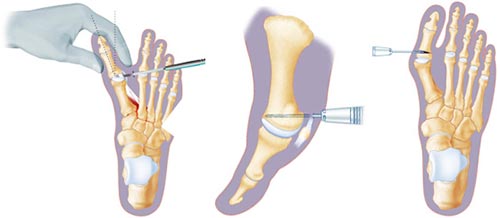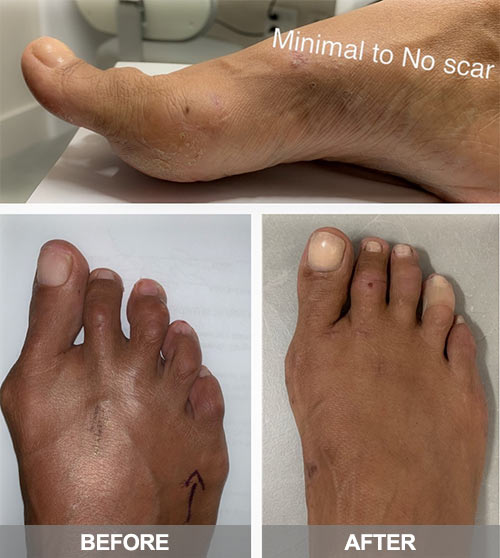Minimally Invasive Foot Surgery
 Our NYC podiatrist place great importance on the aesthetic result of their surgical procedures, as well as their functional outcome. Recent advances have enabled new “no scar” surgical procedures like minimally invasive bunion surgery and hammer toe surgery which provide comparable and often superior results than traditional surgical methods. Your Manhattan foot doctor offers all the latest techniques and treatments. All symptoms, potential procedural/surgical options should always be discussed with your podiatrist after a thorough consultation and examination for an accurate diagnosis and treatment plan.
Our NYC podiatrist place great importance on the aesthetic result of their surgical procedures, as well as their functional outcome. Recent advances have enabled new “no scar” surgical procedures like minimally invasive bunion surgery and hammer toe surgery which provide comparable and often superior results than traditional surgical methods. Your Manhattan foot doctor offers all the latest techniques and treatments. All symptoms, potential procedural/surgical options should always be discussed with your podiatrist after a thorough consultation and examination for an accurate diagnosis and treatment plan.
Recent advances have enabled new “no scar” surgical procedures like minimally invasive bunion surgery and hammer toe surgery which provide comparable and often superior results than traditional surgical methods.
Fear of scarring frightens many people away from surgeries that would greatly help them. We are sympathetic to these fears and will clearly explain our minimally invasive options and the cosmetic outcomes you should expect. Traditionally, both bunion and hammer toes surgery would result in a large visible scare. However, with our minimally invasive foot surgery techniques, you can correct your foot deformities with minimal to no visible scarring. All questions about this procedure will be answered during your consultation with a foot doctor.
Expectations
While there are some surgeries where a minimally invasive approach may yield less superior results, for example, Achilles tendon surgery actually has better results when using this method. Your Manhattan foot doctor recommends minimally invasive techniques whenever possible for both aesthetic and medical reasons. In other words, the foot will look better and heal faster. For your NYC podiatrist, these methods are often a superior choice. Ingrown toenails are usually removed without a scar.
Minimally invasive surgery refers to surgical foot procedures that:
- Usually are performed in the office of your podiatrist or at a surgical center
- Typically are outpatient procedures allowing you to go home the same day
- Rely on very small incisions which minimize scarring and soft tissue disruption
- Use scopes with tiny cameras and instruments
- Leave you with less pain
- Often let you walk out after the procedure with minimal assistance
- Have fewer complications
- Have a quicker recovery period
With all these benefits, it’s no wonder your podiatrist opts for minimally invasive procedures!
What a Foot Doctor Treats with MIS
Minimally invasive techniques enable your Manhattan foot doctor to treat many foot conditions requiring surgery in her office or in a surgical center nearby. Common outpatient surgical procedures include:
- Hammertoe surgery
- Bunion incision
- Endoscopic plantar fascia surgery
- Ankle arthroscopy- camera guided
- Toenail removal
- Wart removal
- Achilles tendon surgery
For procedures such as joint fusions, your foot doctor in New York will need to perform more traditional surgical techniques.
”
★ ★ ★ ★ ★Absolutely wonderful doctor. Very patient, kind, and understanding. I highly recommend if you have any foot/ankle issues.
Minimal Incision Bunion Surgery
Our Podiatrists recommend minimally invasive techniques whenever possible for both aesthetic and medical reasons. In other words, the foot will look better and heal faster.
Minimally invasive bunion surgery performed in our foot clinic differs from a traditional procedure and offers several advantages. New advances in minimal incision techniques and technology have allowed for a shorter operative time, less postoperative pain, and overall an easier and faster recovery period. One of the biggest advantages of choosing a minimally invasive procedure is the ability to perform the bunion correction with minimal trauma or visible scars to the overlying skin and soft tissue.
With technological advancements, this deformity can be corrected resulting in beautiful feet with no visible scars. Your podiatric doctor performs this type of small incision bunion surgery regularly and will discuss what you should expect during your visit.
By avoiding large incisions, less soft tissue gets disrupted during the surgical procedure to remove bunions which results in less swelling and overall pain. The recovery time is also greatly reduced and you will be able to start putting weight on your foot shortly after surgery.

Minimally Invasive Bunion Surgery Before and After
To the right are before and after pictures from real patients who went through minimally invasive bunion surgery in NYC at our center. The scarring after minimal incision removal is barely visible. Our surgeon highly trained in innovative, minimal incision surgical techniques and in using the most advanced surgical equipment available in the USA.
During traditional surgery, many foot surgeons in New York make large incisions in some cases over two and a half inches long. The surgery scar is barely visible in the top picture on the right, thanks to a new minimally invasive technique. Our Podiatrists specialize in performing small incision bunion surgery with minimal or no scars.
According to the study published on PubMed in 2019: This new minimally invasive bunion procedure is a more effective and reliable method of correcting foot deformities (hallux valgus) when compared to traditional procedures. It provides a higher level of satisfaction and excellent outcomes with low complication and recurrence rates. Furthermore, a minimally invasive method improved the cosmetic results by avoiding the formation of a scar.
Doctor’s Note: Not all patients are suitable candidates for minimally invasive bunion surgery. People whose deformity is severe, have other toe deformities, or who had prior bunion removal surgery, may require a more involved surgical procedure. It’s best to consult your orthopedic foot and ankle surgeon to see which treatment option is appropriate for you.
Hammer Toe correction
We offer several options for hiding the incision required by hammer toes surgery without any compromise to the medical outcome. These minimally invasive techniques can easily be performed using a technique that hides the tiny incision between your toe. Alternatively, the incision can be made along natural skin folds existing over the toe joint. These methods follow recommended plastic surgery techniques for optimal healing and scar prevention. Speak to your foot doctor to discuss what surgical option best fits your lifestyle and expectations.
Endoscopic Surgical Techniques
An endoscope is a small camera that sits on the end of a thin, narrow tube. Your podiatry specialist or foot doctor inserts a camera into a small incision made on your foot or ankle and the surgery is performed using the endoscopic camera to guide the procedure. A digital screen magnifies the image from the camera so that your podiatric surgeon can visualize the anatomy through only a small incision.
Endoscopic surgery is wonderful for many reasons such as:
- minimal incision size
- Lower chance of infection
- Less blood loss
- Quicker recovery
- Reduced pain
Why is Minimally Invasive Surgery gaining popularity?
In the past, foot doctors relied on traditional surgical measures requiring large incisions which have longer healing times. Now, minimally invasive solutions are available and cut down considerably on your healing time and can greatly improve the cosmetic result. Seek out a podiatrist who has been trained in minimally invasive bunion surgery and other MIS procedures if you want to have the best available result.
Why is foot surgery moving towards minimally invasive techniques?
- Less trauma to outer skin layers
- Lighter scars that often can be blended into natural skin folds
What Are Minimally Invasive Surgery Risks?
We offer several options for hiding the incision required by hammer toes surgery without any compromise to the medical outcome. These minimally invasive techniques can easily be performed using a technique that hides the tiny incision between your toe.
While your foot doctor expects a great outcome from outpatient, minimally invasive foot surgery, there are always risks involved in surgery. When you meet with your podiatrist, list any medications you’re taking, underlying diseases you may have, and injuries in your past. It can make all the difference in the success of your procedure.
Possible risks include
- Infections
- Abnormal bleeding
- Damage to nerves in your feet
- Blood clots
- Delays in bone healing or bones healing in incorrect positions
All symptoms, potential procedural/surgical options should always be discussed with your podiatrist after a thorough consultation and examination for an accurate diagnosis and treatment plan.
Do you have any questions about Minimally Invasive Foot Surgery procedures in NYC? Would you like to schedule an appointment with an internationally recognized, top NYC Podiatrist and foot doctor at Manhattan Foot Specialists? Please contact our office for a consultation.
In The Press

Call now to make an appointment with our award winning, board certified NYC podiatrists regarding your health. We look forward to seeing you!
book online now (212) 389-9918(212) 389-1886 Podiatrist (Midtown) 51 East 25th Street, Ste 451, NY 10010
(212) 389-1887 Podiatrist (Union Square) 55 W 17th St Ste 106, NY 10011
(212) 378-9991
